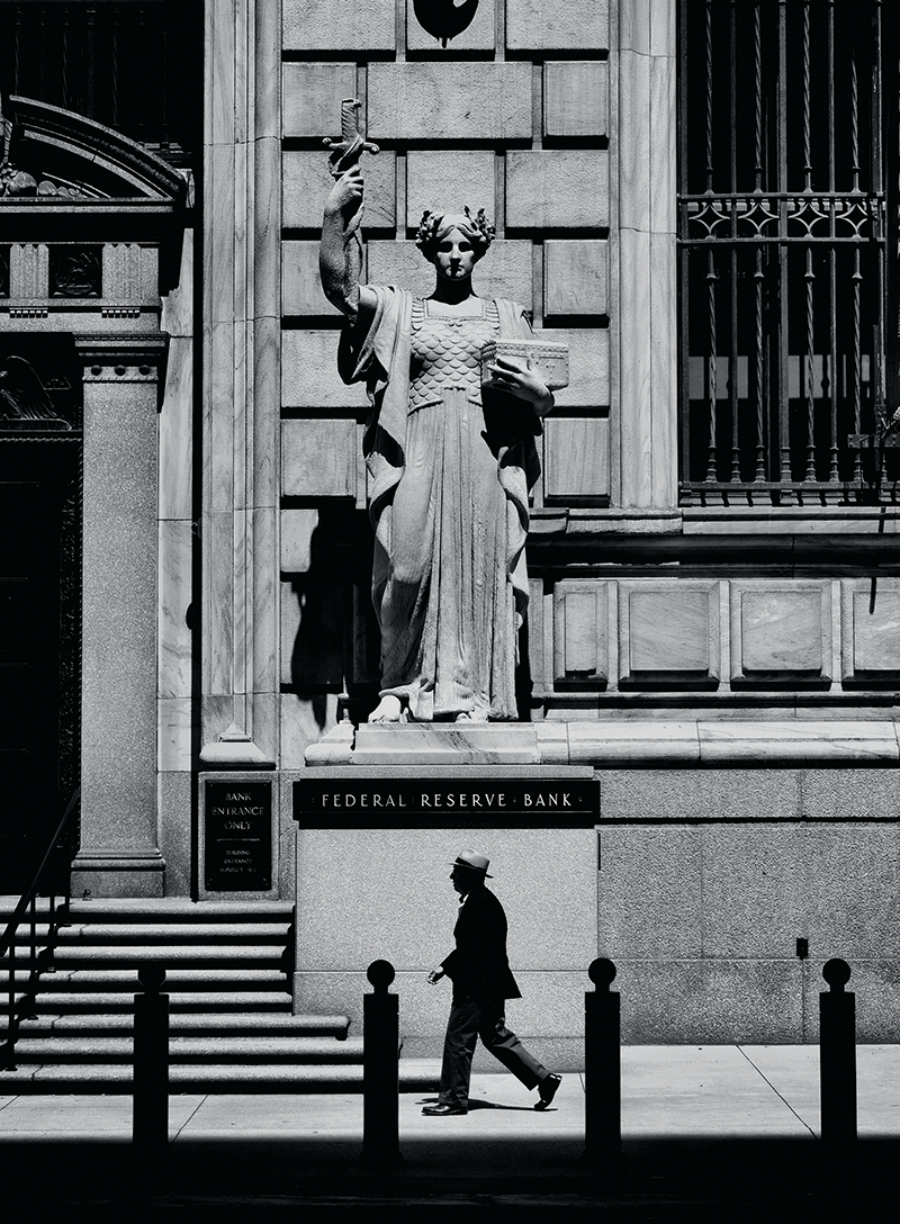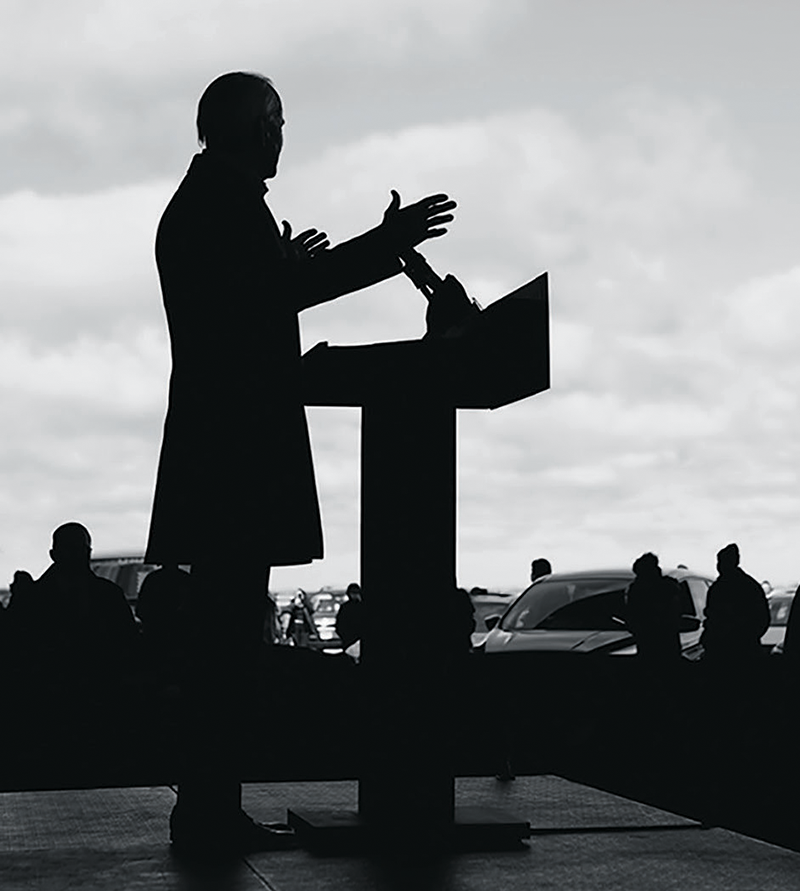
Downtown Cleveland, 2016 (detail) © Matt Black/Magnum Photos. All photographs by Black are from the Geography of Poverty series.
Dedicating the long-delayed Franklin Delano Roosevelt memorial on a sunny May morning in 1997, President Bill Clinton drew enthusiastic applause when he spoke of a “strange irony”: although a quarter of Americans were unemployed in 1932, that figure had shrunk to “fewer than one in twenty,” marking a time of “unprecedented prosperity.”
If the trauma of the Depression years—vividly evoked in the memorial’s sculptures and inscriptions—seemed remote to Clinton’s audience, it has an entirely contemporary feel today. One striking tableau features a row of cold and hungry men waiting outside a door for food—a breadline. “Today we call that a food bank,” the former eight-term Ohio congressman Dennis Kucinich observed to me recently. “Remember the Roosevelt quote on the wall above those figures: one-third of a nation ill-housed, ill-clad, ill-nourished? That’s what we’re looking at.” Kucinich had called to discuss the mounting pain in Cleveland, his home city, which had drawn him to the bleak precedent of the Depression. He had been the “boy mayor” for a single term in the late Seventies, a period marked by a tumultuous battle with business leaders who demanded he sell off the municipal power company, which offered cheaper rates than a private competitor. Vengeful bankers refused to roll over the city’s loans, forcing Cleveland into default and Kucinich out of office. But the electric company stayed out of private hands, saving residents hundreds of millions of dollars over the ensuing decades. It could be considered the Kucinich memorial.
In late 2020, Kucinich told me, the company was planning to disconnect customers with unpaid bills, ending a monthslong moratorium on power cuts effected in response to the pandemic. To compound the misery, the city-owned water company was bent on shutting off delinquent customers’ water. “Even before the pandemic, we were living hand to mouth,” he said. “One in every three families lives in poverty; the weather is getting cold, COVID-19 is raging, and they want to cut off power and water. This was already the second poorest big city in America. Now we’re the poorest.” The draconian measures were slated to go into effect before the New Year, but every sign suggested that things would get even worse as time went on. City revenues from hotel taxes had virtually disappeared; downtown office buildings were emptying out as people worked from their suburban homes. This threatened to deprive the city of a huge slice of revenue from income taxes (the city was fighting to collect the money anyway). Before COVID-19, one person out of every six in the Cleveland area was “food insecure,” the polite term for not knowing where your next meal will come from. By November, the figure had grown to one in five. “People are desperate,” said Kucinich. “We need a New Deal 2.0.”
Cleveland may present an especially grim example. But economic misery abounds across much of the country. The hope may be that coronavirus vaccines will wipe away last year’s hardships, but in the meantime the financial transfusion of the CARES Act has dried up, even as renewed shutdowns and restrictions this winter have led to stagnant job growth and countless blighted lives. Millions of renters face potential eviction and demands for previously deferred rent; people with student loans fear the burden of renewed payments; and cities brace for sinking property-tax revenue—at least three hundred thousand New Yorkers moved out of the city for good last year.
No matter how quickly vaccines are distributed, millions of lives will have been permanently scarred by the disappearance of jobs, businesses, and education. At the very least, a post-pandemic economy will likely revert to what the economist Michael Hudson calls a “slow crash,” as people have less and less money to spend after servicing their debts and paying taxes, inexorably squeezing the consumer spending that makes up 70 percent of economic activity.

Rome, Mississippi, 2017 © Matt Black/Magnum Photos
Election night brought the news that many of these hopes and dreams would need to be tossed overboard. A Biden Administration with a shrunken lead in the House of Representatives and without a majority in the Senate meant that sweeping reforms would be out of the question. Even a wafer-thin Democratic Senate majority would rely on the uncertain loyalties of so-called moderates, most notably Joe Manchin of West Virginia, who has often voted in favor of Donald Trump’s agenda. (So far is the senator removed from any progressive inclinations that he even floated the possibility, early in 2020, of endorsing Trump.) Beyond that, Biden heads a Democratic Party riven with conflict. The dominant establishment wing that spent four years fending off progressive threats to its remunerative control now complains that calls to defund the police and provide universal health care alienated voters. Progressives, who powered much of the grassroots effort to turn out voters for Biden, especially in swing states such as Arizona, Michigan, and Georgia, point out that no Democratic candidate actually called to defund the police and that, furthermore, the numbers show that policies derided as “socialist” are broadly popular—Medicare for All polls at 70 percent approval. Democrats defending seats in swing districts who stood up for such policies won across the board.
Amid such turbulence, history suggests that Biden will look to his old partners on the Republican side of the aisle for solace and support. As I have previously noted in this magazine, Biden has long reveled in his reputation as an arch-dealmaker. He has suggested that bipartisan camaraderie could return to the Senate in Trump’s absence. His record of cross-party cooperation is undeniable. But with rare exceptions, such as the rejection of Robert Bork’s nomination to the Supreme Court, the resulting accords tended to bank sharply to the right, most notoriously those made with Strom Thurmond, his segregationist ally in a series of repressive, racist crime bills, whom he considered “one of [his] closest friends.” Biden’s entire career suggests that, rather than pushing for anything resembling a New Deal 2.0., he will be happy to govern in a quasi-coalition with Mitch McConnell, even though the latter has never shown the slightest interest in compromising on matters important to him, or to the Republican donor base. The result will likely be a conservative government too timid to take “bold action,” fearful of offending the U.S. Chamber of Commerce and content to satisfy the ever-voracious demands of the defense complex.
Much has been made of the abiding friendship between the president-elect and the Senate majority leader, as demonstrated by McConnell’s attendance, alone among Republican senators, at Beau Biden’s funeral. (He even missed watching the Triple Crown Belmont Stakes to be there, a considerable sacrifice for the race-mad Kentucky senator.) “I don’t think there is anybody better to sit down opposite Mitch McConnell and work out something that helps the country than Joe Biden,” Biden’s longtime aide Ted Kaufman told the Wall Street Journal. McConnell himself expresses a certain indulgent affection for Biden, in contrast to his evident contempt for Barack Obama. “The reason we could get a deal done—and that I could work with Joe—was that we could talk to each other,” McConnell wrote in his 2016 memoir. “I could tell him how far we could go, and he would reciprocate, unlike Obama.”
The circumstances of the particular deal in which Biden earned this approving review are instructive. In 2010, the massive Bush tax cuts—famously beneficial for affluent Americans—were set to expire unless reauthorized by the Democratic-controlled Congress. Biden happily acquiesced to a deal with McConnell: the Republicans were granted two more years of the tax cuts (which Democrats had bitterly opposed when Bush originally pushed them through), along with several other items on their wish list, including a cut to the payroll tax that supports Social Security. In return, the Democrats got an extension for unemployment insurance and the American Opportunity Tax Credit for higher-education expenses. The deal passed over objections from many Democrats, including an eight-hour speech on the Senate floor by Bernie Sanders. Two years later, with the extension due to run out at midnight on December 31, 2012, Senator Harry Reid of Nevada, the pugnacious majority leader, was determined to run out the clock and let the cuts die a natural death, thus generating as much as $3.4 trillion in revenue over ten years for a host of social programs and much-needed infrastructure projects. Reid knew he had the upper hand: simply doing nothing would ensure victory, so he steadfastly ignored McConnell’s pleas to negotiate. On the evening of Sunday, December 30, with his back against the wall, McConnell knew where to turn. As recounted in his memoir, he called Biden with a message: “Is there anyone over there who knows how to make a deal? I need you to get up to speed on this, Joe.” Shortly thereafter, he announced on the Senate floor that he had enlisted the aid of the vice president.
Sure enough, Biden was wildly enthusiastic about his own involvement, calling McConnell throughout the night and following day. By Monday evening, the minority leader had what he wanted: 82 percent of the tax cuts made permanent, with the remaining 18 percent slated to bring in $600 billion (as opposed to the forgone $3.4 trillion) over ten years. As reported by Ryan Grim in We’ve Got People, his illuminating history of the rise of progressive power, many Democratic senators, including Sanders, Sherrod Brown, and Sheldon Whitehouse, were disgusted by the sellout, and retired to Sanders’s office to grumble. While they conferred, each in turn received a rambling phone call from the vice president in which he touted the success of his dealmaking while, in his customary style, leaving them no time to dissent. Seven years later, in a Democratic primary debate, Biden had the effrontery to boast that he “got Mitch McConnell to raise taxes by $600 billion.” This was too much for one fellow candidate, Senator Michael Bennet of Colorado, who knew exactly what had happened: “The deal that he talked about with Mitch McConnell was a complete victory for the Tea Party,” he said. “That was a great deal for Mitch McConnell. It was a terrible deal for Americans.”

Joe Biden in Cleveland, 2020 (detail) © Kevin Lamarque/Reuters/Alamy
Given Biden’s ideological outlook, he may well have sincerely believed it was a good deal for Americans. This conclusion is bolstered by his choice of aides, whose connections, professed beliefs, and résumés all too often reflect an affection for government by corporation. One such figure is Michael McCabe, who served as a senior Biden staffer from 1987 to 1995. From there, McCabe transited to the EPA and then to his own consultancy, where one of his clients was the chemical giant DuPont, long dominant in Delaware. (During a 2002 Senate hearing on criminal enforcement of environmental laws, Biden joked that when he was a young senator, those introducing him “would slip and say, ‘Now I want to introduce the senator from DuPont—I mean, Delaware.’ ”) Among DuPont’s most profitable products was Teflon, which is manufactured with PFOA, a chemical compound that has been linked to multiple cancers. After its lethal toxicity came to light in the Nineties, the corporation fought long and hard to ward off penalties and efforts to ban the chemical. As The Intercept has reported, McCabe was a late addition to this campaign. At DuPont, he oversaw negotiations with the EPA on the poisonous product, helping to secure generous terms for its gradual phaseout. Today, Biden’s Environmental Justice Plan pledges to crack down on the use of deadly PFOA-type pollutants. Among the advisers appointed to Biden’s EPA transition team is none other than Michael McCabe.
The case of the DuPont apparatchik sends a depressing message regarding the new administration’s overall institutional personality, which has been further confirmed by Biden’s selection of figures such as Bruce Reed, architect of Clinton’s war on welfare; Brian Deese, austerity hawk and a senior executive at the $7 trillion investment firm BlackRock; Antony Blinken, forever warrior and enabler of Obama-era humanitarian disasters in Iraq, Libya, Syria, and Yemen; and Neera Tanden, the Clinton loyalist known for responding to progressive critics with unbridled venom. Admittedly, there have been some scattered exceptions to this rule, notably Xavier Becerra, picked to head the Department of Health and Human Services despite his record of support for universal health care. But whether he or anyone else touting unorthodox policies can prevail against Wall Street and the corporate lobby is very much open to doubt.
Whatever the ultimate composition of Biden’s team, those forces will have laid significant groundwork for their own agenda with ample helpings of cash. According to the Center for Responsive Politics, the industries categorized as finance, insurance, and real estate delivered an impressive $201,675,240 to the Biden campaign and the PACs that supported him. Lawyers and lobbyists contributed $52,378,087. The grand total of a quarter billion dollars from these two sectors of the corporate universe far surpasses the $28 million contributed by labor unions. For the former constituency, the prospect of a Biden Administration clearly became even more attractive once it was evident that he would have to govern in cooperation with McConnell, as evidenced by the Dow’s two-thousand-point jump in the weeks following the election. “Think of it this way,” Jeff Connaughton, a former Biden staffer, wrote to me recently. “By January 20, every major corporation with a stake in the first-hundred-day agenda will have a ‘McConnell’ and a ‘Biden’ person on the payroll.” In that case, major legislative agreements could be hammered out without anyone having to leave K Street.
Faced with this dire situation, the country will require massive and determined government intervention on a scale last seen under Roosevelt. Democratic politicians both left and center have invoked the prospect of a Green New Deal as a means of reviving the economy in addition to addressing climate concerns. Meanwhile President-elect Joe Biden has promised a host of New Deal–type programs, including a public-health jobs corps, and has committed to supporting major Roosevelt initiatives, especially Social Security, whose revenue he has vowed to increase by upping payroll taxes on Americans earning more than $400,000 a year, while also paying out more to low-income retirees and widowed spouses. His campaign also pledged “bold action” on everything from climate to health care to corporate greed. With polls projecting a blue wave of Democratic victories up and down the ballot, it all seemed within reach.

The United States Employment Service office, San Francisco, 1938. Photograph by Dorothea Lange. Courtesy Prints and Photographs Division, Library of Congress, Washington; Cleveland, 2016 © Matt Black/Magnum Photos
While most signals point to the likelihood that Biden will follow the same path of compromise and surrender pursued by Obama, the president-elect may feel obligated to fulfill at least some of his campaign’s bold promises, faced as he is with an economy in dire straits and a defiantly uncompromising Republican Party. For this, his only means will be executive orders, presidential decrees that require no endorsement from Congress. Trump has endeavored to use executive orders on hundreds of occasions, including when he directed the (partial) construction of his border wall. Biden could use them to more wholesome ends—not only to reverse hundreds of Trump’s malign fiats, but also to forgive student debt or raise the minimum wage for federal workers to $15 an hour. Groups such as 350.org have encouraged Biden to adopt this approach to end oil and gas exports and shut down construction of the Keystone XL pipeline, among other climate initiatives.
Sadly, such aspirations may be doomed, thanks to the long and unremitting campaign by corporate interests to pack the judiciary, an effort crowned at long last with Trump’s bequest of a radical-right supermajority on the Supreme Court. “There’s no doubt that this court is going to be highly suspicious of any aggressive agency actions,” Nicholas Bagley, a law professor at the University of Michigan, told me. Ever since Roosevelt launched the New Deal, a conservative counterrevolution has targeted government agencies such as the EPA and the Securities and Exchange Commission that operate independently of Congress but whose rules nevertheless have the force of law. The administrative state survived and prospered through the Sixties, endorsed by Democratic and Republican administrations alike, but things began to change in the Seventies, as corporations mounted an aggressive pushback. This effort gathered force in the Reagan and Bush eras, barely faltered under Clinton, and achieved warp speed with Trump’s capture of the Supreme Court. With the third branch of government dominated by corporate-friendly interests, Biden is faced with a towering obstacle should he seek to operate outside McConnell’s suffocating embrace.
In a speech at a Federalist Society event in November, Justice Samuel Alito pungently expressed the likely Supreme Court reaction to any unwelcome executive orders from Biden. “Every year,” he declared, “administrative agencies acting under broad delegations of authority churn out huge volumes of regulations that dwarf the statutes enacted by the people’s elected representatives.” As an example, he cited the raft of measures intended to stop the spread of COVID-19, such as restrictions on social gatherings imposed by executive decree, which, he warned, “highlighted the movement toward rule by experts.”
While many might sympathize with such objections, Alito’s target, and that of his fellow Republican appointees on the court, was clearly broader. “This court has an extra dollop of antipathy to the administrative state,” Jody Freeman, director of the Environmental and Energy Law Program at Harvard Law School, told me. Its principal strategy, she said, is to force agencies to stick to the letter of vaguely worded legislation passed by Congress, thus cramping the ability of agencies such as the EPA to confront problems not specified in the original statute. She mentioned the Federal Communications Commission, which is tasked with regulating the internet under the 1996 Telecommunications Act, in which the internet is barely mentioned. Freeman has no doubt about the consequences. “None of the branches of government are handling modern society,” she told me. “Congress isn’t, and so has delegated the job to the agencies. The agencies are being kept in place by the court, meaning the president has no free hand. So nothing gets done for infrastructure, nothing for needed regulation.”
Public concern regarding the radical realignment of the federal courts tends to focus on social issues such as abortion or marriage equality. But corporate power’s tightening grip on the judiciary has lethal implications for any progressive economic agenda, now or in the future. Senator Sheldon Whitehouse of Rhode Island, who opposed the 2012 tax deal, is among the few prominent officials in Washington who has raised this issue. He has assiduously tracked the intricate system by which corporate-friendly judges are vetted, selected, and promoted with dark money, while lawsuits integral to the overall agenda are steered toward the Supreme Court with the aid of coordinated supportive briefs. Expense in this endeavor has clearly been no object; the campaign to confirm Brett Kavanaugh, for example, was fueled by $22 million in anonymous donations, $17 million of which came from a single donor.
I asked Whitehouse what legal bombshells might be on their way to the Supreme Court that could hamper the incoming administration’s plans for New Deal–type initiatives. He pointed to a “super abstruse” California tax case, Americans for Prosperity Foundation v. Becerra, which could make dark money hard to track by limiting state government access to nonprofit donor information. The case has made its way out of the Ninth Circuit and is waiting to get on the Supreme Court docket. “The dark money vultures are gathering there,” he wrote me. It “will give them a dangerous opportunity. . . . Big groups in the dark money conspiracy like the Chamber [of Commerce] and Marathon Petroleum are asserting a First Amendment right to dark money,” which, he added, they need “like the cavalry needs horses.” The likely outcome is that corporate political finance, unconstrained by public scrutiny, will be free to repel irksome interference from executive agencies such as the Consumer Financial Protection Bureau, whose supposedly independent director was fired by Trump after the Supreme Court granted him the power to do so. “I’d say ‘change’ is the loser,” concluded Freeman, the Harvard Law professor. “The winner is corporate America.”

Eviction warnings at the Cuyahoga County Sheriff’s Department, Cleveland, 2008 © Anthony Suau
Cleveland today is rife with examples of our system’s failures. But it also demonstrates what can be done, strewn as it is with legacies of the New Deal, creations of the “big government” so despised by Republicans. The Memorial Shoreway, carrying thousands of cars every day along the city’s lakeside, was built by ten thousand formerly unemployed workers under the auspices of the Works Progress Administration, which also bequeathed Cleveland bridges, parks, baseball diamonds, picnic areas, and public housing (the housing projects were rigidly segregated, a more sinister New Deal legacy). Roosevelt’s approach was a success. Grateful voters returned him and his party to power again and again. Republicans were forced to pursue similar social-welfare policies, as Nixon did in establishing the EPA. (That agency could be considered another Cleveland legacy, since it was created in response to public outcry after the city’s pollution-choked Cuyahoga River spontaneously ignited in 1969.)
In recent years, however, counterattacks on New Deal–style governance have been lubricated by government’s failure to deliver. As James Hayes, an Ohio activist and former Cleveland resident, told me, the overall turnout among poorer voters in the city was down compared with previous elections. “People are not feeling like politics is something that can change their lives for the better, and they’re disengaging from the process and disengaging from democracy,” he said. “Republicans are even picking up more votes within the black community in Cleveland.” He recalled a young black man in the city who had declared his intention to vote for Trump on the grounds that “Obama never gave me $1,200, and Trump did,” in reference to the stimulus checks that the administration sent out last spring.
Biden has pledged to match the help handed out in Trump’s name. He can’t afford not to, lest the forty-fifth president enjoy lasting, unique affection for those $1,200 checks. But if the economy is to pull out of a slow crash, and the Democratic Party is to avoid defeat in 2022 and 2024, Biden must do much, much more. A “return to normalcy” after the pillaging of the Trump years will be difficult, especially because Trump is leaving office rather as Saddam Hussein left Baghdad, with government departments in flames along with anything else that might enable a viable government. Public support for dramatic measures will surely be there if Biden asks for it, but his lifetime of temporizing, coupled with powerful forces of opposition, stand in the way—recall that the president-elect and the establishment he represents still adamantly oppose universal health care, despite polling that indicates broad bipartisan support. They crave normalcy as it existed in 2016. But that was when the country elected Donald Trump.









































































































